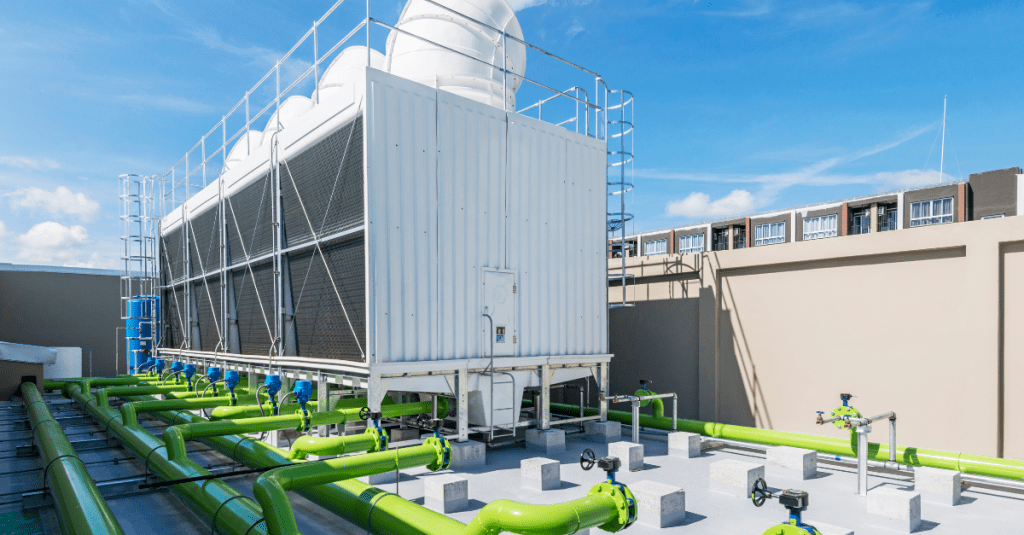Industrial Legionella water treatment is essential for controlling and preventing the growth of Legionella bacteria in water systems within industrial settings. Legionella is a type of bacteria responsible for causing Legionnaires’ disease, a severe respiratory illness that can lead to serious health complications. This bacteria thrives in warm, stagnant water, making it a significant threat in industrial cooling towers, evaporative condensers, and other water-based systems commonly found in large facilities.

Industrial facilities are particularly vulnerable to Legionella growth due to their large, complex water systems. These systems often provide the ideal conditions for the bacteria to flourish—warm temperatures, stagnant water, and the presence of biofilms. Without proper water treatment protocols in place, these environments can quickly become breeding grounds for Legionella, posing significant risks not only to workers but also to the broader public.
The American Industrial Hygiene Association (AIHA) emphasizes the critical role of industrial hygiene in preventing Legionnaires’ disease. The AIHA’s “Technical Framework: Legionella” provides a comprehensive guide for understanding and mitigating the risks associated with Legionella in industrial settings. This framework is essential for any facility manager looking to protect their operations from the dangers of Legionella outbreaks.
Preventing Legionella in industrial settings requires a proactive, multi-faceted approach. This approach should start with the design and maintenance of water systems. Proper system design is crucial in preventing conditions that favor the growth of Legionella. For example, avoiding dead legs (sections of piping where water can stagnate) and ensuring consistent water flow can reduce the likelihood of bacterial growth.
Regular monitoring and maintenance of these systems are equally important. Routine checks should be conducted to identify and rectify any potential issues that could lead to Legionella proliferation. This includes regular cleaning and disinfection of cooling towers and other water-based systems, as well as maintaining water temperatures at levels that inhibit bacterial growth. In hot water systems, for instance, maintaining temperatures above 140°F (60°C) can effectively kill Legionella bacteria, significantly reducing the risk of an outbreak.
Environmental monitoring is another critical component of Legionella prevention. Regular testing of water systems for the presence of Legionella bacteria is essential. This allows for early detection and intervention, preventing minor issues from escalating into serious health risks. Industrial facilities should implement a robust monitoring plan that includes periodic water sampling and analysis, coupled with immediate corrective actions if Legionella is detected.
Industrial hygienists play a pivotal role in the prevention of Legionnaires’ disease within industrial environments. These professionals are equipped with the knowledge and expertise to assess the risks associated with Legionella and to develop effective control measures. They work closely with facility managers to ensure that water systems are properly maintained and that preventive measures are consistently applied.
Training and education are also key elements in a successful Legionella prevention strategy. Industrial hygienists should work to educate all staff members on the risks of Legionella and the importance of following established protocols. This includes training on how to recognize potential Legionella hazards, how to conduct routine inspections, and how to respond in the event of a detected outbreak.
When it comes to specific applications in industrial settings, such as cooling towers, hot water tanks, and process water systems, a tailored approach is necessary. In cooling towers, for example, a combination of chemical treatments and physical methods is often employed. Chlorine-based disinfectants are commonly used to kill Legionella bacteria in the water, while filtration systems can help remove bacterial cells from the water, further reducing the risk of contamination.
Hot water tanks also require careful management. Keeping the water at a temperature that is inhospitable to Legionella—typically above 140°F—is a straightforward but effective method for controlling bacterial growth. In process water systems, the approach may vary depending on the specific use case and operational requirements. However, a combination of chemical treatments, physical barriers, and engineering controls is often the most effective way to manage Legionella risks in these environments.
The benefits of a well-implemented Legionella water treatment program are manifold. First and foremost, it significantly reduces the risk of Legionnaires’ disease outbreaks, thereby protecting the health of both employees and visitors to the facility. Furthermore, such a program ensures compliance with local and national regulations, which often mandate strict control measures for Legionella in industrial water systems.
Beyond health and compliance, there are also economic benefits to consider. Legionnaires’ disease outbreaks can lead to substantial downtime and production losses, not to mention the potential legal liabilities. By proactively managing Legionella risks, facilities can maintain smooth operations and avoid the costly consequences of an outbreak.
In summary, industrial Legionella water treatment is a critical component of facility management that cannot be overlooked. By adopting a comprehensive approach that includes proper system design, regular maintenance, environmental monitoring, and staff training, industrial facilities can effectively manage the risks associated with Legionella. Protecting public health, ensuring regulatory compliance, and maintaining operational continuity are just a few of the many reasons why a robust Legionella water treatment program is essential.
Contact ChemREADY today to learn more about how our tailored Legionella water treatment solutions can safeguard your industrial facility.
Legionella is a bacteria that causes Legionnaires’ disease, a severe respiratory illness. In industrial settings, it can thrive in warm, stagnant water systems like cooling towers and hot water tanks, posing a significant health risk.
Prevention involves a combination of water system design, regular maintenance, environmental monitoring, and staff training. Specific treatments include chemical disinfectants, temperature control, and filtration.
The American Industrial Hygiene Association (AIHA) provides comprehensive guidelines, including the “Technical Framework: Legionella,” which offers best practices for assessing and controlling Legionella risks.
Legionella bacteria thrive in warm water. Maintaining hot water systems at temperatures above 140°F (60°C) is crucial for killing any bacteria present.
Implementing Legionella water treatment reduces the risk of Legionnaires’ disease, ensures regulatory compliance, and minimizes the potential for operational downtime and production losses.